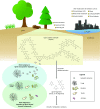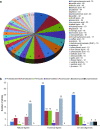Mapping the diversity of microbial lignin catabolism: experiences from the eLignin database
- PMID: 30963208
- PMCID: PMC6486533
- DOI: 10.1007/s00253-019-09692-4
Mapping the diversity of microbial lignin catabolism: experiences from the eLignin database
Abstract
Lignin is a heterogeneous aromatic biopolymer and a major constituent of lignocellulosic biomass, such as wood and agricultural residues. Despite the high amount of aromatic carbon present, the severe recalcitrance of the lignin macromolecule makes it difficult to convert into value-added products. In nature, lignin and lignin-derived aromatic compounds are catabolized by a consortia of microbes specialized at breaking down the natural lignin and its constituents. In an attempt to bridge the gap between the fundamental knowledge on microbial lignin catabolism, and the recently emerging field of applied biotechnology for lignin biovalorization, we have developed the eLignin Microbial Database ( www.elignindatabase.com ), an openly available database that indexes data from the lignin bibliome, such as microorganisms, aromatic substrates, and metabolic pathways. In the present contribution, we introduce the eLignin database, use its dataset to map the reported ecological and biochemical diversity of the lignin microbial niches, and discuss the findings.
Keywords: Aromatic metabolism; Bioconversion; Catabolic pathways; Database; Ecological niche; Lignin.
Conflict of interest statement
The authors declare that they have no competing interests.
Figures





Similar articles
-
Catabolism of β-5 linked aromatics by Novosphingobium aromaticivorans.mBio. 2024 Aug 14;15(8):e0171824. doi: 10.1128/mbio.01718-24. Epub 2024 Jul 16. mBio. 2024. PMID: 39012147 Free PMC article.
-
Insights on kraft lignin degradation in an anaerobic environment.Enzyme Microb Technol. 2024 Sep;179:110468. doi: 10.1016/j.enzmictec.2024.110468. Epub 2024 Jun 3. Enzyme Microb Technol. 2024. PMID: 38850683
-
Exploring the Lignin Catabolism Potential of Soil-Derived Lignocellulolytic Microbial Consortia by a Gene-Centric Metagenomic Approach.Microb Ecol. 2020 Nov;80(4):885-896. doi: 10.1007/s00248-020-01546-1. Epub 2020 Jun 22. Microb Ecol. 2020. PMID: 32572536
-
Bacterial catabolism of lignin-derived aromatics: New findings in a recent decade: Update on bacterial lignin catabolism.Environ Microbiol Rep. 2017 Dec;9(6):679-705. doi: 10.1111/1758-2229.12597. Environ Microbiol Rep. 2017. PMID: 29052962 Review.
-
Biomanufacturing of value-added chemicals from lignin.Curr Opin Biotechnol. 2024 Oct;89:103178. doi: 10.1016/j.copbio.2024.103178. Epub 2024 Aug 3. Curr Opin Biotechnol. 2024. PMID: 39098292 Review.
Cited by
-
Recent Advancements and Challenges in Lignin Valorization: Green Routes towards Sustainable Bioproducts.Molecules. 2022 Sep 16;27(18):6055. doi: 10.3390/molecules27186055. Molecules. 2022. PMID: 36144795 Free PMC article. Review.
-
Metabolic engineering of Pseudomonas putida for production of vanillylamine from lignin-derived substrates.Microb Biotechnol. 2021 Nov;14(6):2448-2462. doi: 10.1111/1751-7915.13764. Epub 2021 Feb 3. Microb Biotechnol. 2021. PMID: 33533574 Free PMC article.
-
Biodegradation of lignin monomers and bioconversion of ferulic acid to vanillic acid by Paraburkholderia aromaticivorans AR20-38 isolated from Alpine forest soil.Appl Microbiol Biotechnol. 2021 Apr;105(7):2967-2977. doi: 10.1007/s00253-021-11215-z. Epub 2021 Mar 9. Appl Microbiol Biotechnol. 2021. PMID: 33687503 Free PMC article.
-
Characterization of Two Marine Lignin-Degrading Consortia and the Potential Microbial Lignin Degradation Network in Nearshore Regions.Microbiol Spectr. 2023 Jun 15;11(3):e0442422. doi: 10.1128/spectrum.04424-22. Epub 2023 Apr 12. Microbiol Spectr. 2023. PMID: 37042774 Free PMC article.
-
Vanillin Production in Pseudomonas: Whole-Genome Sequencing of Pseudomonas sp. Strain 9.1 and Reannotation of Pseudomonas putida CalA as a Vanillin Reductase.Appl Environ Microbiol. 2020 Mar 2;86(6):e02442-19. doi: 10.1128/AEM.02442-19. Print 2020 Mar 2. Appl Environ Microbiol. 2020. PMID: 31924622 Free PMC article.
References
-
- Abejón R, Pérez-Acebo H, Clavijo L. Alternatives for chemical and biochemical lignin valorization: hot topics from a bibliometric analysis of the research published during the 2000–2016 period. Processes. 2018;6(8):98. doi: 10.3390/pr6080098. - DOI
Publication types
MeSH terms
Substances
Grants and funding
LinkOut - more resources
Full Text Sources
Molecular Biology Databases
Miscellaneous

